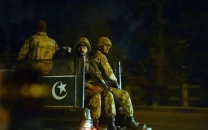Targets in Pakistan: Only 12% of drone victims identified as militants, says report
2,370 people have been killed in the US drone attacks since 2004

Research undertaken by the Bureau of Investigative Journalism reveals that only 12% of drone victims in Pakistan have been identified as militants.
Moreover, the research also stated that fewer than 4% of the people killed have been identified as members of al Qaeda.
Interestingly, the research contradicts US Secretary of State John Kerry’s claim last year that only “confirmed terrorist targets at the highest level” were fired at.
Of the 2,370 people killed in the US drone strikes since 2004, only 295 were reported to be members of some armed group.
More than a third of them were not designated a rank, and almost 30% are not even linked to a specific group.
The Bureau has a project titled Naming the Dead, which has gathered the names and details of people killed by CIA drones in Pakistan since June 2004.
According to Mustafa Qadri, a Pakistani researcher for Amnesty International, the findings “demonstrate the continuing complete lack of transparency surrounding US drone operations.”
Responding to the Bureau’s investigation, US National Security Council spokesperson Caitlin Hayden said that the strikes were only carried out when there was “near-certainty” that no civilians would be killed.

“The death of innocent civilians is something that the US Government seeks to avoid if at all possible,” Hayden said.
“In those rare instances in which it appears non-combatants may have been killed or injured, after-action reviews have been conducted to determine why, and to ensure that we are taking the most effective steps to minimise such risk to non-combatants in the future,” Hayden added .
Published in The Express Tribune, October 18th, 2014.

















COMMENTS
Comments are moderated and generally will be posted if they are on-topic and not abusive.
For more information, please see our Comments FAQ